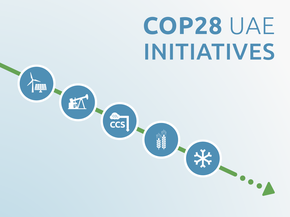Assumptions
Historical emissions
Historical emissions excl. LULUCF for the period 1990–2021 are taken from PRIMAP (Gütschow et al., 2022). LULUCF emissions for the years 1994, 2000, 2005 and 2014 are taken from the UNFCCC GHG Inventory database (UNFCCC, n.d.). LULUCF emissions for 2019 are taken from the UAE’s 2023 NDC, which includes historical emissions values for all IPCC sectors for the year 2019 (Government of the UAE, 2023a).
There are significant uncertainties when it comes to historical, energy-related CO2 emissions, with estimates from different sources varying significantly. We compared data reported by PRIMAP (Gütschow et al., 2022), the IEA (IEA, 2021b) and BP (BP, 2022)for energy-related CO2 emissions in the UAE in the period 2010 and 2019, and found an average difference of 60% between the lowest and highest reported values, with years where differences are above 90%. For example, in 2019 the lowest estimate (PRIMAP) reported 141 MtCO2 while the highest (BP) reported 270 MtCO2 for energy-related CO2. Due to the lack of up-to-date official data, and the large discrepancies found between different sources, there is a significant uncertainty surrounding the UAE’s actual energy-related CO2 emission levels. This is also in turn the UAE’s single largest emission source, accounting for 64% of the total (excl. LULUCF) in 2021.
NDC
The absolute emissions level for the NDC target incl. LULUCF is taken directly from the NDC document.
F-gases
Because F-gases are excluded from the UAE’s latest NDC target, the CAT adds them into the quantification of the NDC by assuming that F-gases remain constant from the last historical year (2021) until the target year (2030). F-gases represent only ~0.3% of the UAE’s total emissions.
LULUCF
The target in the UAE’s 2023 NDC includes LULUCF emissions. To estimate the emissions level resulting from the target excluding LULUCF, we take the value for its 2030 LULUCF target (included in the NDC) and subtract it from the main NDC target.
Global Warming Potential (GWP) values
The UAE’s 2023 NDC specifies that its currently uses AR4 both for the BAU scenario and the NDC and sectoral targets. For the 2020 NDC, which was presented in SAR, we converted the 2030 BAU value from SAR to AR4 using a conversion factor for the last available nationally reported historical data point (2014).
Current policy projections
There are no up-to-date emissions projections for the UAE. For our current policy projections, we estimate the impacts of the 2050 Energy Strategy on emissions with a range to reflect for uncertainties around the efficiency target and total energy generation.
We use IRENA’s Renewable Energy Prospects report as our basis for energy-related CO2 emissions (Masdar Institute/IRENA, 2015) and calculate the difference in emissions that would result from the 2050 Energy Strategy.
The upper end of our range reflects the installed capacity targets for 2030 in the 2050 Energy Strategy, without calculating the impacts of energy efficiency measures. For this projection, we estimate total power generation by technology using capacity factors estimated based on the IRENA REMAP BAU scenario (Masdar Institute/IRENA, 2015).
The lower end of the projections includes both the installed capacity and efficiency targets. For this projection, we assume that total power generation estimates from the IRENA REMAP BAU scenario will be met. We use capacity factors from REMAP for nuclear and renewables. For fossil gas power generation, we assume that it will be used to meet the entire difference between the amount of power generated by nuclear and renewables, and the total generation estimate from REMAP.
In summary, the CPP range for the UAE’ energy-related CO2 emissions is based on assumptions both about which targets will be implemented, as well as the role of fossil gas in the development of the power system.
For CO2 process emissions (from industry), we continue a linear trend based on total industrial process emissions from the years 2010–2021 until 2030 (Masdar Institute/IRENA, 2015). For non-CO2 emissions, we apply the growth rate from the Global Anthropogenic Non-CO2 Greenhouse Gas Emissions: 1990–2030 to PRIMAP historical data (US EPA, 2019).
We use the following data sources in our estimates:
- Energy-related CO2 from fuel combustion: “Renewable Energy Prospects – United Arab Emirates” (Masdar Institute/IRENA, 2015)
- CO2 process emissions (from industry): Own assumption to continue linear trend based on total industrial process emissions from the years 2010–2021 until 2030.
- Non-CO2 emissions: Global Anthropogenic Non-CO2 Greenhouse Gas Emissions: 1990–2030 (US EPA, 2019)
- Historical installed capacity data: IRENA capacity and generation statistics 2023 (IRENASTAT, 2023)
- Historical electricity generation data: IEA World Energy Balances 2022 (IEA, 2022)
- Historical emissions factors: IEA Emissions Factors 2021 (IEA, 2021a).
Net-zero target and other long-term targets
The UAE provides no transparent assumptions on their estimated carbon dioxide removals to meet their 2050 net-zero CO2 target. For this reason, we keep the latest available LULUCF inventory data for 2019 (presented in the UAE’s 2023 NDC) of -1 MtCO2e constant until 2050 (Government of the UAE, 2023a) . We assumed that CO2 emissions will decline at a linear rate between 2030 and 2050 to balance LULUCF removals in 2050. We further assume that non-CO2 emissions will decline at a linear rate between 2030 and 2080 in line with the IPCC SR1.5 pathways.
Global Warming Potentials values
The CAT uses Global Warming Potential (GWP) values from the IPCC's Fourth Assessment Report (AR4) for all its figures and time series.
Further analysis
Latest publications
Stay informed
Subscribe to our newsletter




